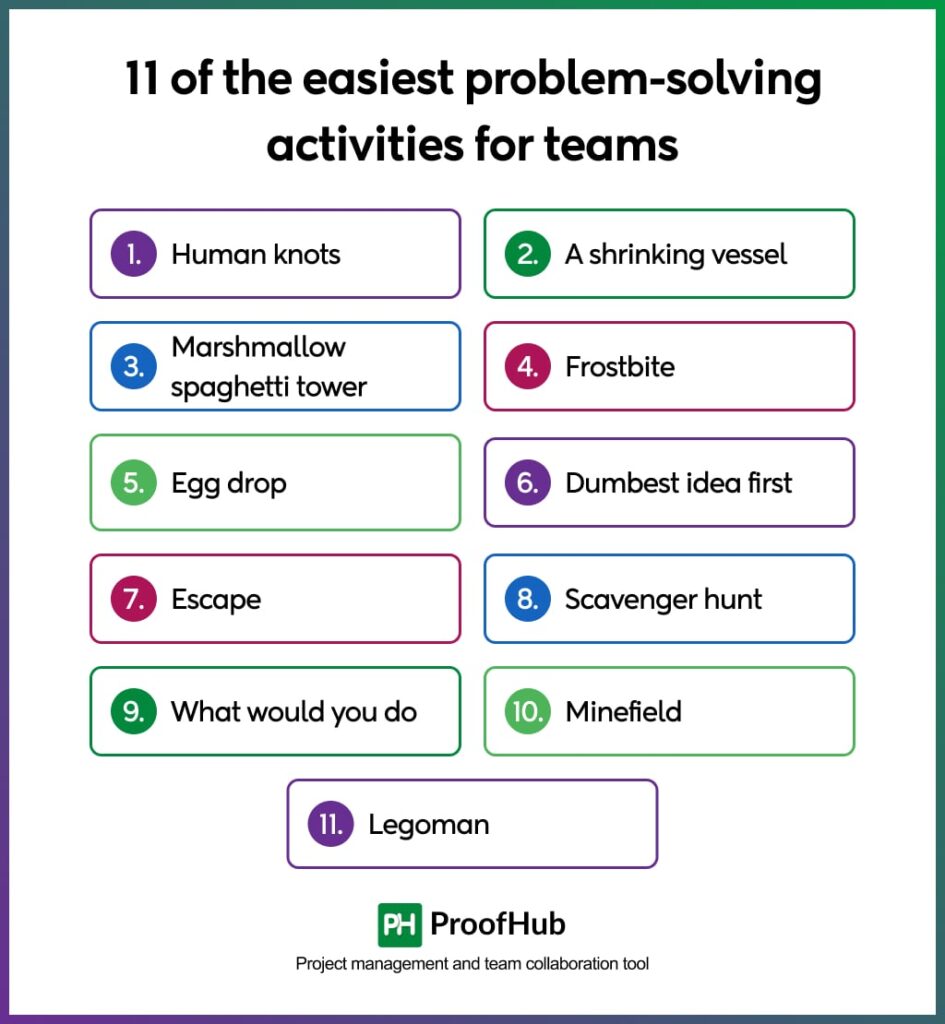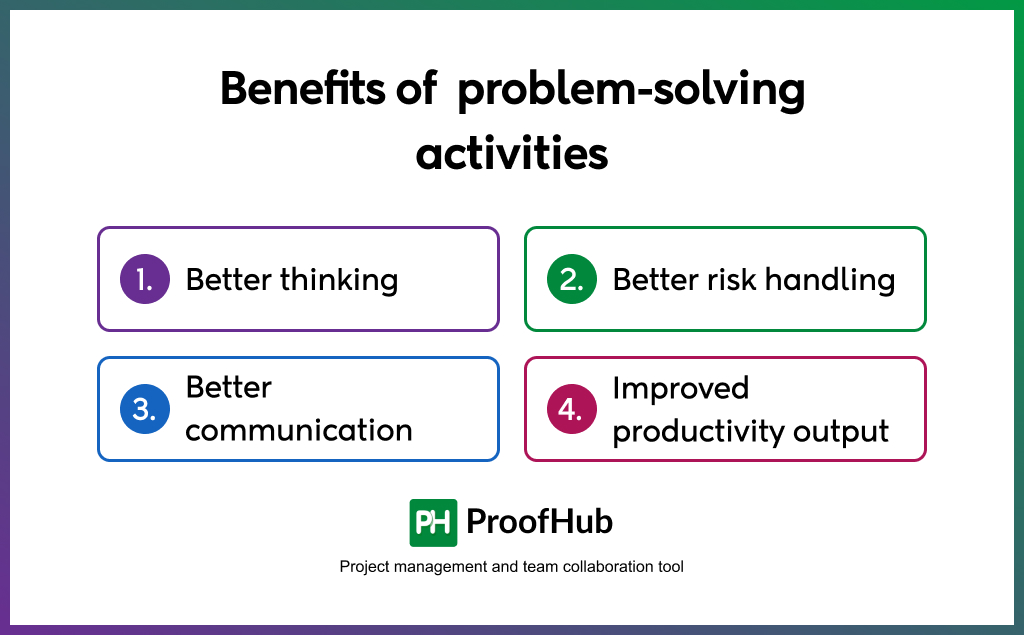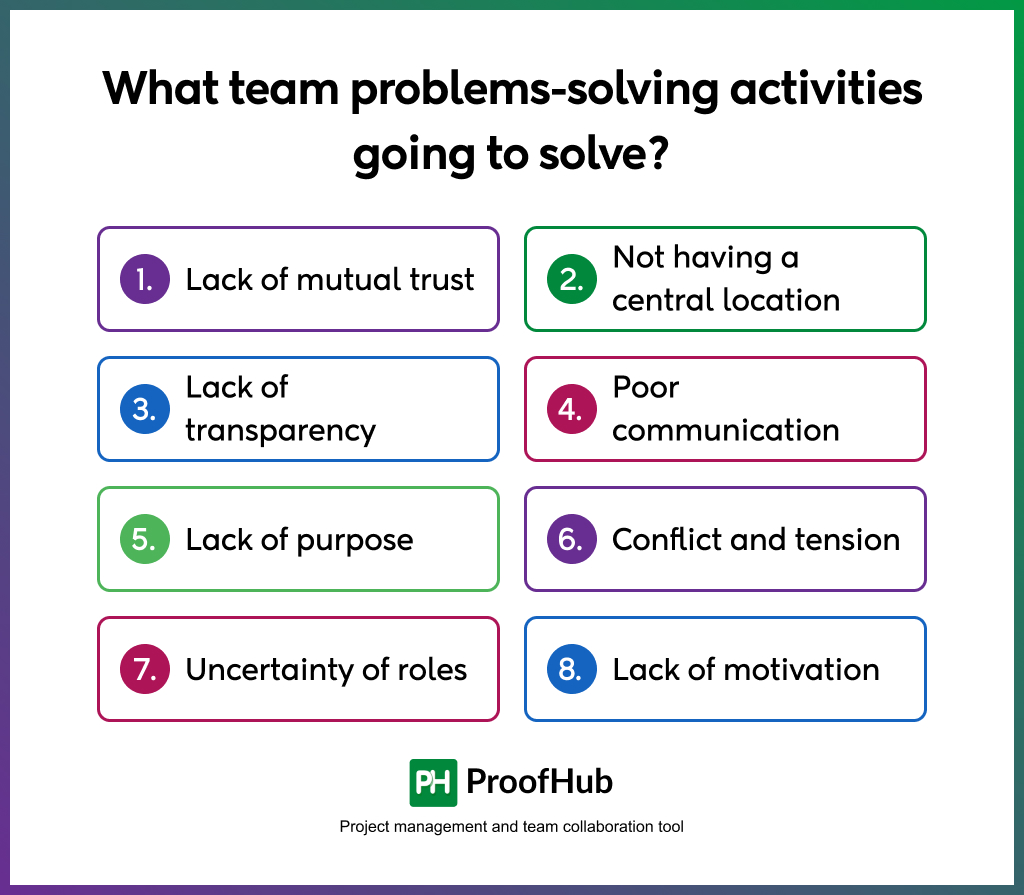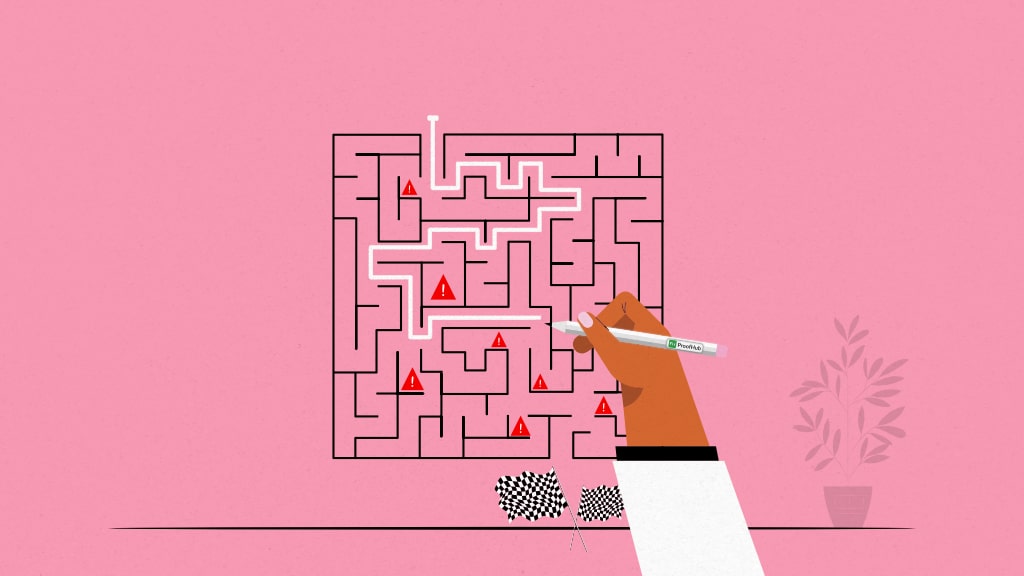Introduction
Problem-solving activities are a great way to learn how team members identify problems, react to them, find potential solutions quickly, and then implement the best ones.
Several types of problems might occur when working with a team, and as a leader, your mindset should be to guide your team to solve those problems.
You have to take the initiative to make your team better at generating creative solutions when things go wrong.
In this article, you will find the best problem-solving activities designed to encourage teamwork and unlock your team’s creativity.
Why team building activities are important?
- Encourages teamwork: These activities bring individuals together to collaborate, communicate, and combine their diverse skills to solve challenges more effectively, strengthening teamwork and collective effort.
- Enhances critical thinking: Participating teams need to analyze situations, identify root causes, and brainstorm solutions, which helps improve their logical reasoning and decision-making skills.
- Fosters creativity: These activities encourage innovative and unconventional thinking, inspiring participants to explore different ideas and develop creative solutions.
- Builds trust in the team: Working together on problem-solving tasks improves communication and strengthens team bonds, creating a foundation of mutual trust and respect within the team.
- Improves adaptability: These activities help participants learn how to handle uncertainty and adapt to changes, building resilience and flexibility.
- Boosts confidence: Completing challenges fosters a sense of achievement, boosting individual self-confidence and improving team morale by celebrating collective wins.
- Promotes growth mindset: Problem-solving exercises emphasize learning from failures, teaching participants to approach obstacles as opportunities for growth and improvement.
11 Easiest problem-solving activities for teams of all sizes

There are some amazing creative activities out there that can work well for team building. These will help you test your team’s problem-solving abilities while they learn how to bring their best qualities forward for effective collaboration.
These creative problem-solving games will break the monotony at the workplace and help you create a more inclusive and welcoming environment for the whole team. For effective team building, these are some of the easiest activities that will help bring substantial change to your team culture and the workplace as a whole.
1. Human knots
Helps with: Collaboration & communication skills
Estimated time: 15-20 minutes
Things you’ll need: Nothing
How to do it:
Make your team stand in a small circle. If your team is large, then you can divide it into smaller groups and make them stand in multiple circles. Each person should hold the hands of two other people standing in the circle, but not of those who are standing directly beside them.
This should result in creating a “human knot.” The fun part (also the challenging) begins now. Ask each group member to untangle themselves without letting go of each other’s hands. You can set a time limit if you want. You can watch your team members as they work out moves to untangle their bodies.
This activity allows them to communicate and collaborate to solve the problem quickly. They may or may not fully entangle themselves but would have started to work together to solve the problem.
Why communication is essential to problem-solving
No problem is big enough when working as a team. A bunch of committed individuals can collaborate to overcome even the most difficult hurdles. When all team members come together and put in a joint effort as per strategy, the problem will likely be resolved sooner.
Having problems communicating your ideas to the team? Use ProofHub discussions to keep track of ideas and important pitches.
2. A shrinking vessel
Helps with: Adaptability & Quick Thinking
Estimated time: 10-15 Minutes
Things you’ll need: A rope and a ball of yarn
How to do it:
Place a rope in a particular shape on the floor so that all your team members can stand inside it. If your team is large, you can divide it into smaller groups using multiple ropes.
The challenging part starts when all team members are made to stand inside the rope, and you start to shrink the rope slowly. Team members must make subtle adjustments as space reduces to maintain their position and balance inside the shrinking circle.
No one should step outside the circle. The challenge before your team is to quickly think together about how to keep everyone inside the circle.
Why adaptability is essential to problem-solving
This amazingly effective problem-solving activity is for teams facing adaptability issues. Adaptability and cognitive diversity go hand in hand, enabling your team to work things out faster. People and organizations that can adapt quickly usually come out on top because they can condition themselves to change circumstances and environments and take on board new ideas and concepts.
3. Marshmallow spaghetti tower
Helps with: Collaboration
Estimated time: 20-30 Minutes
Things you’ll need (per team):
- 20 sticks of uncooked spaghetti
- 1 marshmallow
- A yard of string
- A single roll of masking tape
How to do it:
Ask your team to utilize all the available materials to construct the tallest tower within a specific period. The tower must stand on its own and support a marshmallow.
This problem-solving activity trains the team to think independently while encouraging prototyping and iteration. It also helps to promote and build strong camaraderie and leadership.
Why collaboration is essential to problem-solving –
Peter Singe, in the Fifth Discipline, writes, “Collectively, we can be more insightful, more intelligent than we can be individual.” This means we can solve problems better when working as a team than we can alone.
This problem-solving activity emphasizes team collaboration, which is crucial for the success of any group, irrespective of its size. It also shows that success is dependent upon close collaboration between team members.
4. Frostbite
Helps with: Decision Making, Trust, Leadership
Estimated time: 20-30 Minutes
Things you’ll need:
- Blindfolds
- An electric fan
- Construction materials (toothpicks, cardstock, rubber bands, sticky notes, etc.)
How to do it:
Divide your team into groups of 4-5 people each (applicable for large teams). Each team should have its leader to guide them. Remember, team leaders cannot use their hands to help their respective groups. Now, the fun part of this problem-solving activity is that team members are blindfolded, so they can’t use their hands!
Every team is given 30 minutes to build a tent. The time is set to create a sense of urgency within the team. For example, give your team a scenario where they have to make a tent to save themselves from approaching thunderstorms. The tent should be able to withstand high winds from the storm.
After the game is over, you can turn on the fan to see which tent can stand on its own even after withstanding winds blowing at high speed.
This problem-solving activity aims to improve team members’ listening skills so that they can execute the task according to the leader’s instructions.
Why decision-making is essential to problem-solving
When managing teams and projects, team managers are responsible for making decisions that affect everyone. Decision-making is essential to problem-solving because if the right decision is made at the right time, it could resolve the problem, eventually benefiting the entire team and the organization.
5. Egg drop
Helps with: Decision Making & Collaboration
Estimated time: 10-15 Minutes
Things you’ll need:
- A carton of eggs
- Construction materials (balloons, rubber bands, straws, tape, plastic wrap, etc.)
- A place where you can let things get messy!
How to do it:
Give a single egg to each team and let it choose randomly from different construction materials. The task that is to be assigned to each team is to create a carrier for an egg that prevents it from breaking.
Once teams are done with creating carriers, place an egg in them and drop them (from over a ledge or a balcony), one by one. The purpose is to find which team’s carrier (s) can save an egg from breaking.
If multiple eggs remain unbroken, you can keep increasing the height of the fall to find out the last egg that survives even after falling from a higher height. The winning team is the one that created the most durable carrier that survived until the last.
The idea behind this problem-solving activity is to encourage all team members to work together to achieve a common goal.
Why teamwork is essential to problem-solving
Joint efforts by a group of individuals to achieve the set target by utilizing limited resources can save the organization valuable time, money, and resources.
6. Dumbest idea first
How it helps: Critical Thinking & Creative Problem Solving
Estimated time: 15-20 minutes
Things you’ll need: A piece of paper, pen, and pencil
How to do it:
As the name of this problem-solving activity suggests, you present a problem to your team and ask them to quickly come up with the dumbest ideas for solving it. The problem could be a real-world problem that your team is facing or an imagined scenario.
Once all team members have written down the dumbest ideas they could think of, evaluate every idea to determine which ones are most likely to work and which ones are least likely to be seen as a viable solution that can work.
How critical thinking is essential to problem-solving
Some problems need to be solved by out-of-the-box thinking. Creative problem-solving ideas might sound unorthodox to work, but these give you additional options to consider. You can discover some solutions that might not be obvious to start with but can be incredibly effective in delivering expected results.
Brainstorm these dumb (or not so dumb) ideas in ProofHub through online chat. And start your uninterrupted collaborative journey for FREE today.
7. Escape
How it helps: Communication, Problem-solving, & Management
Estimated time: 20-30 Minutes
Things you’ll need:
- A lockable room
- One rope
- One key
- 5-10 puzzles or clue
How to do it:
Hike the key and a list of clues around the room. Ask team members to solve all the clues to find the key and unlock the room to escape within the allotted time. Hide the clues and, most importantly, the key around the room.
Ask all team members to enter the room and lock the door. Give them 30 minutes or 1 hour to find the key using the clues hidden in the room. This problem-solving activity can get your team going as they race against the clock to find a solution to the problem at hand.
How putting intensive efforts is essential to problem-solving
Complex problems require an intensive team effort. Your team can achieve specific, time-bound goals by collaborating closely and thinking quickly under pressure.
8. Scavenger Hunt
How it helps: Teamwork, communication & creative thinking
Estimated time: 30–60 minutes
Things you’ll need
- A list of items, tasks, or clues
- A defined area for the hunt
- Small rewards or prizes (optional)
How to do it:
Divide participants into small teams and provide each team with a list of items or tasks they must complete within a specified time. Scatter the items or clues in the designated area. Teams must work together to locate or accomplish the tasks while following the instructions provided. The first team to find all the items or complete the tasks wins.
To make it more engaging, include riddles or clues that lead to each item, encouraging critical thinking and collaboration among team members.
9. What Would You Do
How it helps: Ethical decision-making & Perspective sharing
Estimated time: 15–30 minutes
Things you’ll need
- Scenario cards or descriptions of hypothetical situations
- A comfortable space for discussion
How to do it
Present participants with a series of hypothetical scenarios that involve a problem or moral dilemma. These scenarios can range from workplace challenges to everyday ethical situations. Each participant or team takes turns explaining what they would do in the given situation and why they chose it.
Encourage open discussions after each scenario, where others can share alternative viewpoints or approaches. This fosters a deeper understanding of different perspectives and problem-solving styles.
10. Minefield
How it helps: Teamwork, Communication & Trust Building
Estimated time: 20–30 minutes
Things you’ll need
- A designated space (indoor or outdoor)
- Objects to serve as “mines” (e.g., cones, balls, or papers)
- Blindfolds
How to do it
Set up a “minefield” by scattering objects around a defined area. Divide participants into pairs, with one person blindfolded and the other acting as their guide. The guide must use verbal instructions only to navigate their partner safely through the minefield without touching any “mines.”
To add complexity, include time limits or obstacles that require strategic planning. Rotate roles so everyone experiences both guiding and navigating.
11. Legoman
How it helps: Teamwork, communication & attention to detail
Estimated time: 20–40 minutes
Things you’ll need:
- A set of LEGO bricks (multiple sets for teams if available)
- A table for each team
- A pre-built LEGO model as a reference
How to do it
Divide participants into small teams. Assign one team member as the “architect,” who can view the pre-built LEGO model, and the others as the “builders.” The architect must describe the model to the builders using verbal instructions only, while the builders recreate it without seeing the original.
The challenge lies in precise communication, as the architect cannot physically assist or show the model. Once completed, compare the recreated models to the original and discuss the outcomes.
What are the benefits of problem-solving activities?
“But how problem-solving activities are going to help me, my team members, and the organization?” Many readers, especially team managers, must consider this question while reading this article.

I understand that readers want to know how problem-solving activities can benefit them. So, I have prepared a list of the pros of such activities to develop positivity in the workplace. Read on to know more about it.
1. Better thinking
Problem-solving activities help bring out the best in every team member. Every member enthusiastically presents his unique idea for solving the problem. This helps team managers weigh different solutions for resolving a problem and then choose the most suitable one. In other words, this process stimulates better thinking.
For example – A remote team with widely dispersed members was struggling with a lack of communication. Emails and texting were just not good enough. Mike was leading the team, and he asked all members to suggest ways to improve communication within the remote team.
2. Better risk handling
Some people can handle a higher amount of risk because they have successfully dealt with difficult situations before. Team problem-solving activities help condition individuals’ minds so they can better respond to stressful situations.
3. Better communication
Regular communication between team members can help to solve problems efficiently. Problem-solving activities within teams foster cooperation and intra-team communication, eventually creating a better understanding between team members.
4. Improved productivity output
When a team works as a strong unit, the company or organization experiences improved productivity, eventually improving profit margins. The involvement of managers and team members in problem-solving activities can positively affect the company’s overall growth and profitability.
How often should groups engage in problem-solving activities?
Groups should engage in problem-solving activities regularly, such as monthly or quarterly, to maintain collaboration and critical thinking skills. You should carefully keep the frequency of activities so that they remain engaging and relevant to the teams and they do not feel overburdened.
When is the best time to engage in problem-solving activities?
The best time to engage in team-building exercises are:
- During onboarding
- Team-building events
- Post-project reviews
- When facing bottlenecks
What problems are solved with these activities?

1. Lack of mutual trust
Trust is the basis of strong relationships. No team can hope to achieve success if members do not want to engage with each other and make that human connection that is vital for better collaboration.
Team members should first know each other well, professionally and personally, primarily before they are assigned a large, complex project where tensions will run high.
2. Not having a central location for information sharing
When some team members do not get easy access to crucial information related to a project, it can lead to a dreaded information gap. Scattered information makes matters worse for managers and team members.
Having all the information stored and organized in a single location, in the form of files and folders, makes information accessibility easy for all team members. Team members can collaborate on them effectively, review, proof, and share feedback in one place, which saves a whole lot of time.
3. Lack of transparency
“According to an American Psychological Association survey that spoke to more than 1,500 workers, it was found that 50% didn’t feel that their employers shared the information they required to be successful within their jobs.”
Teams, managers, and clients must be on the same page for any project to succeed. Without transparency, trust will take a backseat within the team, leading to a plethora of problems that can spell doom for the company.
The task of establishing transparency starts at the top. Project managers are responsible for setting a prime example for their team members in terms of their conduct. Employees are likely to follow their leader’s behaviors, whether positive or negative, and it becomes your responsibility to inspire them through positive actions.
4. Poor communication
“David Grossman reported in “The Cost of Poor Communications” that a survey of 400 companies with 100,000 employees each cited an average loss per company of $62.4 million per year because of inadequate communication to and between employees.”
Poor communication happens when it doesn’t happen regularly across the team, and not all members participate in it. It can also occur when team members interrupt one another, maintain silence, and indicate problems but fail to address them formally. Some members may nod in agreement but may not agree in reality.
Using different communication modes can bridge the gap between team members. At the same time, encouraging members to share their ideas and concerns openly can also help clear any misunderstandings, doubts, and confusion.
5. Lack of purpose
“One in two employees report that their jobs lack purpose, and an equal number feel disconnected from their company’s mission.”
If I think about the teams I least enjoyed working with, they were the ones that had a vague understanding of their purpose and how they planned to achieve that goal. It’s hard to put in your best efforts when you don’t know the purpose behind your work. The most satisfying teamwork occurs when the purpose is well-defined, and team members are aligned with each other.
6. Conflict and tension
“$359 billion in paid hours or the equivalent of 385 million working days are lost each year due to workplace conflict.”
Conflicts and tension can be healthy and trigger useful debates if managed carefully. However, team members can often cross the line. The negative effects of workplace conflict include but are not limited to, poor productivity, absenteeism, work disruptions, project failure, lower retention rates, and termination. Different opinions in the workplace are common, but their mishandling can spell troubles for an organization.
Team leaders can practice constructive criticism to help employees realize their shortcomings without humiliating them. You can appreciate their strengths, but you should not hesitate to point out their weaknesses (in performance or conduct) in an affirmative tone.
7. Uncertainty of roles
This is a common problem, especially among large teams. Some team members are unclear about their roles, what they should do, and when. The blame game happens. Team members blame their managers and vice versa, and it’s all due to poor task management.
By creating and assigning custom roles, managers can allow team members or clients to perform tasks that fall within their work domain and job responsibilities.
8. Lack of motivation
“When managers recognize employees’ contribution, their engagement increases by 60%”.
Having demotivated employees working for you is probably your organization’s biggest misfortune. However, have you ever tried to find out why some of your employees lose motivation? It can be due to not being appreciated at work, not feeling like a part of the team, personal reasons, etc.
Whatever the reason may be, a team manager should quickly confront the situation to solve it for good. Having one-on-one discussions with team members can go a long way in helping you to know about the exact reasons behind their below-par performance and come up with effective solutions.
How management tools can help you sort out your team collaboration problems
Even though the aforementioned problem-solving activities can be amazingly effective in enhancing collaboration and communication within your team, there’s no denying the fact that using a top-rated team collaboration and project management software like ProofHub can help team managers solve quite a few problems efficiently.
Whether you’re having trouble with delayed communication, poor organization of files and folders, poor time management, inadequate task management, or low control over teams and projects, ProofHub is your all-in-one solution to put an end to your managerial woes and help you and your team achieve more in less.
Some powerful features of ProofHub include:
- Workflows and Kanban Boards
- Online Proofing
- Gantt Charts
- Group Chat
- Online Discussions
- Custom Reports
- Timer and Timesheets
- Third-party Integrations
- Announcements
- IP Restrictions
Pricing – Simple pricing for all team sizes. For information on our pricing plans, kindly visit our pricing page.
The final thought
Many organizations face a plethora of problems that haunt their teams consistently. These problems have a rippling effect on the team’s performance, hamper its productivity, and cause delays in the organizational goals.
However, problem-solving activities can bring all team members closer and encourage them to contribute to resolving problems effectively while having fun. These easy problem-solving activities can improve your team’s solutions-generating capabilities, eventually benefiting everyone.

